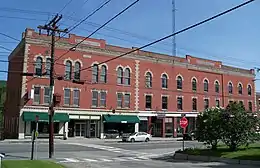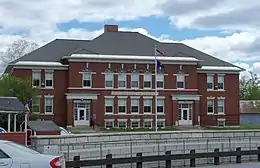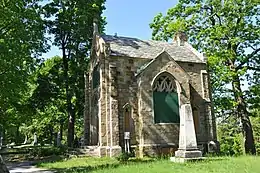Chase R. Whitcher
Chase R. Whitcher (1876–1940) was a notable American architect practicing in Manchester, New Hampshire, during the first half of the twentieth century.
Chase Roy Whitcher | |
|---|---|
 Whitcher c. 1907 | |
| Born | December 8, 1876 |
| Died | August 25, 1940 (aged 63) |
| Occupation | Architect |

Life and career
Chase Roy Whitcher was born December 8, 1876, in Lisbon, New Hampshire, to Ward Priest Whitcher and Pheeb H. (Perkins) Whitcher.[1] He studied architecture at the Massachusetts Institute of Technology and with architects in Boston, but did not receive a degree. In 1898 Whitcher returned to Lisbon, where he began working as an architect, probably with local contractor L. W. Goudie. In 1903 he established an independent architect's office in Lisbon. Circa 1907 he moved this office to Manchester, but kept his residence and family in Lisbon. By 1909, his wife and children had joined him in Manchester. For his entire time in Manchester, Whitcher kept his office in the Beacon Building, the city's most prestigious business address. Whitcher was in continuous practice in Manchester until his death in 1940. He was assisted during his career by at least two other architects, George O. Peabody and Roland S. Simonds, and several draftsmen.[2] New Hampshire architects Carl E. Peterson and Malcolm D. Hildreth also worked in his office.[3]
In August 1913 Whitcher was appointed New Hampshire's second and last State Architect,[lower-alpha 1] having charge of design and construction of buildings at the various state institutions. The office was abolished in 1915.[2]
After Whitcher's death, Simonds continued the practice, working until his own death in 1963.[5]
Personal life
In 1898 Whitcher married Eda M. Aldrich, also a native of Lisbon. They had two daughters.[1][2]
After several years of renting in Lisbon and Manchester, circa 1915 Whitcher built a home for his family at 1153 Union Street in Manchester. This was a traditional Colonial Revival home, and Whitcher lived there until his death.[2]
Whitcher died August 25, 1940, in Manchester.[2]
Legacy
Almost all of Whitcher's buildings were designed in the popular Colonial Revival and Beaux-Arts styles, with only occasional forays in the Gothic Revival or eclectic styles. During his lifetime, Whitcher was best known as an architect of schools and public buildings, but is today best remembered for Hampshire House at The Balsams in Dixville Notch, one of the largest and most elaborate buildings of its time in New Hampshire.[6]
At least six of Whitcher's works have been listed on the United States National Register of Historic Places, and others contribute to listed historic districts.
Architectural works
- Bank Block, Lisbon, New Hampshire (1902)[7]
- Boynton Block, Lisbon, New Hampshire (1902)[7]
- Dow Academy, Franconia, New Hampshire (1903, NRHP-listed 1982)[8]
- Littleton Hospital (former),[lower-alpha 2] Littleton, New Hampshire (1906–07)[2]
- Laconia Hospital, Laconia, New Hampshire (1907–08, demolished)[9]
- Pembroke Village School (former), Suncook, New Hampshire (1907–08)[10]
- Remodeling of the Dunlap Building,[lower-alpha 3] Manchester, New Hampshire (1908, NRHP-listed 2004)[11]
- Beaumont Hall, Tilton School, Tilton, New Hampshire (1909)[12]
- Bedford Town Hall, Bedford, New Hampshire (1909–10, NRHP-listed 1984)[13]
- Quinby Building, Laconia State School, Laconia, New Hampshire (1909)[2]
- Bath Town Hall, Bath, New Hampshire (1910)[2]
- Colebrook Academy, Colebrook, New Hampshire (1910–11)[2]
- Lincoln Chambers,[lower-alpha 4] Manchester, New Hampshire (1910–11)[2]
- Warner Town Hall, Warner, New Hampshire (1910)[2]
- Brown School (former), Manchester, New Hampshire (1911–12)[2]
- Maynard School (former), Manchester, New Hampshire (1911–12)[2]
- Soldiers Memorial Building,[lower-alpha 5] Deerfield, New Hampshire (1913–14)[14]
- First Congregational Church, Lisbon, New Hampshire (1914)[2]
- Portsmouth State Armory, Portsmouth, New Hampshire (1914–16, demolished 2004)[2]
- Mary Lyon Hall, Plymouth State University, Plymouth, New Hampshire (1915–16)[15]
- Merchants National Bank Building,[lower-alpha 6] Manchester, New Hampshire (1915, demolished)[16]
- Stratford Public School, North Stratford, New Hampshire (1915–16)[17]
- Hampshire House, The Balsams, Dixville Notch, New Hampshire (1916–18, NRHP-listed 2002)[6][18]
- Manchester Practical Arts High School (former), Manchester, New Hampshire (1920)[2]
- Weston School, Manchester, New Hampshire (1921)[19]
- A. Crosby Kennett High School (former),[lower-alpha 7] Conway, New Hampshire (1922–23)[20]
- Manchester Country Club, Bedford, New Hampshire (1922–23)[2]
- Brown Building, New Hampshire State Hospital, Concord, New Hampshire (1923–24)[2]
- Millville School, Concord, New Hampshire (1923, NRHP-listed 1985)[21]
- Capitol Theatre and Masonic Temple, Concord, New Hampshire (1925–27)[2]
- Huntress Hall, Keene State College, Keene, New Hampshire (1925–26)[2]
- Masonic Temple, Manchester, New Hampshire (1925)[2]
- Butterfield Hall, Keene State College, Keene, New Hampshire (1926–27)[2]
- Lisbon Public Library, Lisbon, New Hampshire (1926)[2]
- Public Service Company of New Hampshire Building, Manchester, New Hampshire (1926)[2]
- General Draper High School,[lower-alpha 8] Hopedale, Massachusetts (1927)[22]
- Rhodes Hall,[lower-alpha 9] Keene State College, Keene, New Hampshire (1927–28)[2]
- Col. Town Community House, Lancaster, New Hampshire (1927)[23]
- Cogswell Memorial School, Henniker, New Hampshire (1930–31)[24]
- Pembroke Fire Station (former), Suncook, New Hampshire (1930)[2]
- Tobey Building, New Hampshire State Hospital, Concord, New Hampshire (1930)[2]
- Chapel, Valley Cemetery, Manchester, New Hampshire (1932, NRHP-listed 2004)[25]
- Spaulding Memorial School, Townsend, Massachusetts (1932)[2]
- Greenville Consolidated School, Greenville, Maine (1933)[26]
- Pfeiffer Hall, Tilton School, Tilton, New Hampshire (1938)[27]
- Spaulding High School, Rochester, New Hampshire (1938–39)[2]
Gallery of architectural works
 Bank Block and Boynton Block, Lisbon, New Hampshire, 1902.
Bank Block and Boynton Block, Lisbon, New Hampshire, 1902. Dow Academy, Franconia, New Hampshire, 1903.
Dow Academy, Franconia, New Hampshire, 1903. Remodeling of the Dunlap Building, Manchester, New Hampshire, 1908.
Remodeling of the Dunlap Building, Manchester, New Hampshire, 1908. Bedford Town Hall, Bedford, New Hampshire, 1909–10.
Bedford Town Hall, Bedford, New Hampshire, 1909–10. Bath Town Hall, Bath, New Hampshire, 1910.
Bath Town Hall, Bath, New Hampshire, 1910. Colebrook Academy, Colebrook, New Hampshire, 1910–11.
Colebrook Academy, Colebrook, New Hampshire, 1910–11. Warner Town Hall, Warner, New Hampshire, 1910.
Warner Town Hall, Warner, New Hampshire, 1910. Soldiers Memorial Building, Deerfield, New Hampshire, 1913–14.
Soldiers Memorial Building, Deerfield, New Hampshire, 1913–14. First Congregational Church, Lisbon, New Hampshire, 1914.
First Congregational Church, Lisbon, New Hampshire, 1914. Hampshire House, The Balsams, Dixville Notch, New Hampshire, 1916–18.
Hampshire House, The Balsams, Dixville Notch, New Hampshire, 1916–18..jpg.webp) Manchester Practical Arts High School, Manchester, New Hampshire, 1920.
Manchester Practical Arts High School, Manchester, New Hampshire, 1920.
.jpg.webp) Huntress Hall, Keene State College, Keene, New Hampshire, 1925–26.
Huntress Hall, Keene State College, Keene, New Hampshire, 1925–26..jpg.webp) Rhodes Hall, Keene State College, Keene, New Hampshire, 1927–28.
Rhodes Hall, Keene State College, Keene, New Hampshire, 1927–28. Chapel, Valley Cemetery, Manchester, New Hampshire, 1932.
Chapel, Valley Cemetery, Manchester, New Hampshire, 1932..jpg.webp) Pfeiffer Hall, Tilton School, Tilton, New Hampshire, 1938.
Pfeiffer Hall, Tilton School, Tilton, New Hampshire, 1938. Spaulding High School, Rochester, New Hampshire, 1938–39.
Spaulding High School, Rochester, New Hampshire, 1938–39.
Further reading
- Hobart Pillsbury, New Hampshire: Resources, Attractions and its People—A History 5 (Boston: Lewis Historical Publishing Company, 1927)
- Laura B. Driemeyer, Chase Roy Whitcher: A Monograph (Kensington: Preservation Company, 2008)
Notes
- Whitcher replaced J. Edward Baker of Manchester, who had filled the office since it was established in May of 1913.[4]
- Presently a senior residence known as Beattie House.
- Originally built in 1879.
- Presently known as Cathedral Place.
- A contributing building to the Deerfield Center Historic District, listed on the NRHP in 2002.
- Manchester's second skyscraper, following the Amoskeag Bank Building.
- Presently the A. A. Crosby Kennett Middle School.
- A contributing building to the Hopedale Village Historic District, listed on the NRHP in 2002.
- Originally known as Spaulding Gymnasium.
References
- William F. Whitcher, Descendants of Chase Whitcher of Warren, N. H. (Woodsville: News Book and Job Print, 1907)
- Laura B. Driemeyer, Chase Roy Whitcher: A Monograph (Kensington: Preservation Company, 2008)
- Lisa Mausolf, Mid 20th Century Architecture in NH: 1945–1975 (Concord: New Hampshire Department of Employment Security, 2012)
- "Personals," American Contractor 34, no. 36 (September 6, 1913): 131.
- "Roland Scott Simonds." aiahistoricaldirectory.atlassian.net. AIA Historical Directory of American Architects, n. d. Accessed November 1, 2021.
- Bryant F. Tolles Jr., The Grand Resort Hotels of the White Mountains: A Vanishing Architectural Legacy (D. R. Godine, 1998)
- "Building Intelligence," American Architect and Building News 7, no. 1884 (July 5, 1902): xi.
- "New Hampshire," Journal of Education 57, no. 19 (May 7, 1903): 300.
- Fifteenth Annual Report of the Receipts and Expenditures of the City of Laconia, New Hampshire, for the Year Ending February 15, 1908 (Laconia: Laconia Press Association, printers, 1908)
- Annual Reports of the Selectmen, Treasurer, Highway Surveyors, Library Trustees and Board of Education of the Town of Pembroke for the Fiscal Year Ending February 15, 1908 (Concord: J. Phaneuf & Son, printers, 1908)
- Dunlap Building NRHP Registration Form (2004)
- "New Hampshire," American Architect 96, no. 1756 (August 18, 1909): 10.
- Bedford Town Hall NRHP Registration Form (1984)
- Deerfield Center Historic District NRHP Registration Form (2002)
- "Manchester, N. H.," American Contractor 36, no. 31 (July 31, 1915): 58.
- "New England," Bankers Magazine 91, no. 3 (September 1915): 448.
- Jeannette R. Thompson, History of the Town of Stratford, New Hampshire, 1773–1925 (Concord: Rumford Press, printers, 1925)
- The Balsams NRHP Registration Form (2002)
- "Buildings," Engineering and Contracting 55, no. 7 (February 16, 1921): 34.
- "Building," Engineering News-Record 89. no. 7 (August 17, 1922): 92.
- Millville School NRHP Registration Form (1985)
- "HOP.2", mhc-macris.net, Massachusetts Historical Commission, n. d.
- Annual Report of the Town Officers of the Town of Lancaster for the Fiscal Year Ending January 31, 1928 (Lancaster: 1928)
- Henniker Historical Society, The Only Henniker on Earth (Henniker: Henniker Historical Society, 1980)
- Valley Cemetery NRHP Registration Form (2004)
- Engineering News-Record 110, no. 19 (May 11, 1933): 19.
- Engineering News-Record 119, no. 27 (December 30, 1937): 32.